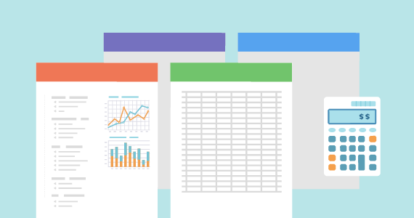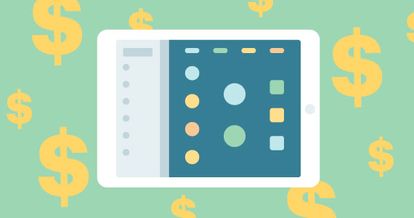Your financial spreadsheets are the backbone of your restaurant’s health.
But if you know only the current state of your restaurant’s finances, you’re not getting the whole story. You’re missing out on the best part: the future.
As a business owner or manager, you need to be diligent about updating your financial projections so you can:
- Take early measures to address low profits
- Know how to plan for future investment
- Set realistic revenue targets
- Tweak your operations for more efficiency – before emergencies hit
You want to be careful not to confuse these statements with your profit and loss statement. While a profit and loss statement shows you what’s happening in your business over a period of time, your financial projections look to the future. This help you anticipate how much revenue you’ll bring in and how much you’ll spend on operations.
Whether you’re a new restaurant owner or a seasoned veteran, you’ll want to make sure you’re properly projecting your revenue and expenses. So we’ve consolidated the following four financial spreadsheets that work together (with formulas!):
- Revenue spreadsheet template
- Controllable costs spreadsheet template
- Financial forecast spreadsheet template
- Startup costs spreadsheet template

Create a full financial forecast with our easy-to-use templates.
These four spreadsheets work together to create a financial forecast spreadsheet that will give you full visibility into how you can expect your restaurant to perform. Here’s how to populate each sheet to get the most accurate financial projections for your restaurant.
Why You Need Financial Forecasts
Imagine you’re driving somewhere you’ve never been before. Chances are, you’re going to look ahead: look at a map, estimate how long the distance would take you to travel, maybe reach out to somebody who’s traveled the route and knows more. You may not know 100% what’s coming, but you make your best educated guesses to plan ahead.
And if you didn’t have a plan, you’d end up lost, and likely not getting very far.
The same goes for your financial forecasting. If you don’t have any plan or direction for your restaurant, you’re going to be spinning your wheels.
Even though your forecasts likely won’t be perfect (unless you’re psychic, which gives you a majoradvantage), they’re an important tool for guiding your business’ future. They will help you decide how to act today and set yourself up for the best tomorrow. They’re an essential business planning tool.
Also, if you ever choose to seek out additional financing for your restaurant, whether it be through personal credit or business loans, you’ll need financial forecasts to share. Lenders will want to see when they’re getting their money back. By taking the time to regularly update your forecasts, you’re preparing yourself to cross that bridge when you get to it with confidence, instead of in a panic trying to show how your business will grow.
How to Use Your Restaurant Financial Spreadsheets
If you don’t have a finance background, these calculations can seem daunting. But don’t fret! As you go through forecasting each time and get more comfortable, it keeps getting easier.
We’ll go through what each of the four spreadsheets tells you about your business, how to fill it in, and why each spreadsheet is important.
1. Revenue Spreadsheet Template
Your revenue spreadsheet template shows you:
- Your total expected revenue
- Your revenue split between food and drink
Here’s how to use your revenue spreadsheet:
Step 1: Enter the amount of days during the week when your restaurant is open.
Step 2: Under “Weekends & Holidays”, enter the number of weekend days and holidays when your restaurant is open.
Step 3: Enter your average sales for one midweek day.
Step 4: The spreadsheet automatically doubles your midweek sales number to generate the weekend and holidays sales number. Adjust this number based on your own weekend and holiday sales.
Step 5: Enter the percentage of sales that is usually attributed to food and drink.
How can you plan anything without knowing how much money you’ll have to work with? By predicting your future revenue, you can better plan your next business move – whether it be more staff, new equipment, or a second location.

2. Controllable Costs Spreadsheet Template
Your revenue number from the first worksheet will transfer over to your controllable costs worksheet. Also known as your “prime costs”, your controllable costs spreadsheet template shows you:
- How much you’re spending on food and drink
- How much you’re spending on labor
- Your restaurant’s operational profit margin
These numbers reveal a lot of valuable information about your business. When you know how much you’re spending on food and drink, you can gauge if you should be repricing menu items. If labor is costing too much, you’ll know early and can start making changes to offset the costs.
Step 1: Calculate your Cost of Goods Sold– you should end up with a percentage number for your food and beverage. (Note that for most venues 25%–40% is a good food cost ratio, and 20%–35% is a good beverage cost ratio.)
Step 2: Enter your food cost percentage and your beverage cost percentage.
Step 3: Tally your labor costs separately for your kitchen, front of house, and management staff. Based on your sales, you should be able to come up with a percentage of labor costs.
Step 4: Enter your labor percentages for your kitchen and front of house staff.
Step 5: Enter the amount you spend on management staff in a dollar amount.
Keep this Excel spreadsheet close and keep an eye on what it reveals about your food costs, labor, and your profit margin. By constantly looking at your controllable costs, you’ll spot when something isn’t looking right early and make the necessary changes before it eats away at your profit.

3. Financial Forecast Spreadsheet Template
Your total revenue, gross profit, and operating profit percentage has carried over from the two previous spreadsheets. Your financial forecast spreadsheet template shows you:
- How much you’re spending on “controllable” expenses such as marketing
- How much you’re spending on “non-controllable” expenses such as rent and utilities
- How much profit you’re left with after these expenses
Step 1: Calculate percentages for how much you spend on advertising and promotion, kitchen supplies, restaurant supplies, and credit card fees based on your current revenue.
Step 2: Enter all percentages where indicated.
Step 3: Enter amounts for all other expenses indicated on the spreadsheet.
Your bottom two lines are now your restaurant’s total income amount and profit margin.
If you want to expand your business, get new equipment, or, really, just stay in business, this spreadsheet is key to your success. If you don’t know where you’re going financially, it’s impossible to make any decisions.
For example, your forecast reveals a slower winter. Because you’ve forecasted this, you’re able to safety judge that this may not be the best time to buy that neon sign you’ve been dying to get for behind the bar.

4. Startup Cost Spreadsheet Template
These three spreadsheets are key to your success, whether your restaurant is five years or five minutes old. But – bonus spreadsheet! – startup costs for a new restaurant may be just as critical to track. If you’re just starting out (or expanding to a new location) and your restaurant hasn’t opened yet, we put together an additional restaurant opening spreadsheet to help you keep on top of your costs.
Starting a restaurant is a large undertaking, so you’ll want to be diligent about your costs right from the start to make sure you’re spending your startup capital in the right way.

While it may not be the most glamorous part of owning a restaurant, updated financial
projection spreadsheets make all the difference in making long-term decisions about your restaurant. Know your numbers ahead of time and avoid emergency financial situations as much as possible – so you can ultimately enjoy owning your dream restaurant.

Create a full financial forecast with our easy-to-use templates.
Download our free inventory template
Sign up for our free weekly TouchBistro Newsletter







